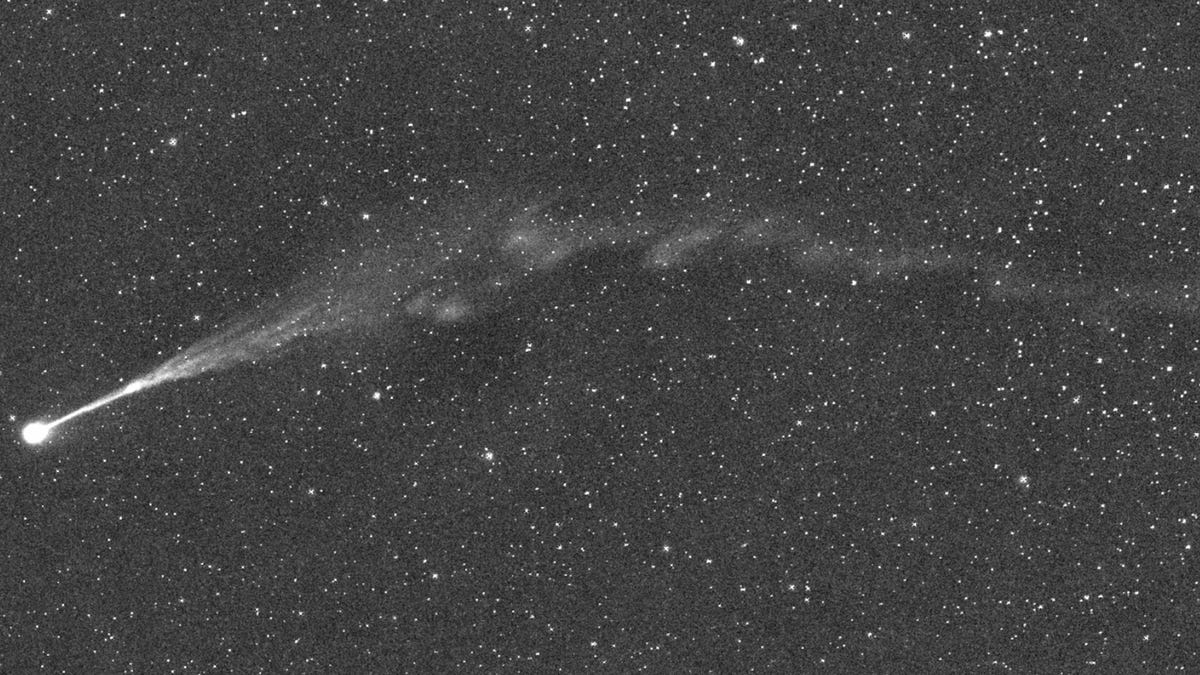The most promising comet of 2023 will make a close pass by our planet next week and it’s nearly bright enough already to be seen with the naked eye.
Comet C/2023 P1 (Nishimura) was first spotted last month by Hideo Nishimura, an amateur astronomer in Japan, using only a digital camera setup and a lot of skill. It’s set to make a close pass by Earth on Sept. 12, and then whip around the sun on Sept. 17 before being flung back out to deep space.
The comet is a bit tricky to see right now because it’s best seen in a dark sky, but its position is such that it should be observed 60 to 90 minutes before dawn, when the sky is not fully dark. A number of sky watchers and astrophotographers are reporting having luck imaging it using a digital camera on a tripod taking exposures that last at least a few seconds.
Nishimura is expected to grow brighter as it comes closer the next few days, if it survives that long.
So far the comet has been meeting some serious resistance in the form of blasts of charged particles and plasma issuing forth from a tumultuous sun. Observers like astrophotographer Michael Jaeger (see above) watched Saturday as a solar storm engulfed the comet and appeared to blow a portion of its tail away for a moment.
Here’s a more dramatic example that was captured by NASA in 2007 of Comet Encke having its tail briefly stolen:
Comet Encke suffered a disconnection event in 2007.
“Researchers call this a disconnection event; it’s caused by a CME (or fast solar wind stream) hitting the comet,” former NASA astronomer Tony Phillips wrote at Spaceweather.com. “Nishimura’s tail has since grown back — but it might not last for long. More CMEs are heading its way.”
CME stands for coronal mass ejection, which is an eruption from the outer layers of the sun that often accompanies a solar flare. Think of it as a very strong gust of energetic wind coursing through space and causing electromagnetic chaos. This is the same force that causes auroras to light up the skies when it collides with Earth’s magnetic field. It can also influence other things in space, like asteroids and comets.
The sun is currently building toward the peak of its roughly 11-year solar cycle, which means more frequent flares and CMEs. At least two more of the ejections Phillips mentioned issued forth from the sun’s corona on Tuesday, exploding in the direction of Comet Nishimura.
Comet Nishimura (C/2023 P1) on Sept 5, 2023. For this single shot I used my A7s and a 135mm lens.
Nishimura is a new comet that was discovered on August 11, 2023. It’s expected to brighten to a magnitude of 1.8. Its closest approach to us will be on Sep 12 and its perihelion on… pic.twitter.com/BXhDo0IOpq— Dr. Sebastian Voltmer (@SeVoSpace) September 6, 2023
How to catch the comet
All this rough space weather can be a bit distressing for skywatchers hoping to see the comet with the naked eye. Although the comet is still approaching Earth, now could be the ideal time to start looking for it. Nishimura was expected to be bright enough to see as soon as Sept. 8. In the Northern Hemisphere it will appear near the horizon, making it a bit tougher to locate.
“It’s really best seen with binoculars or a telescope,” Alison Klesman, who holds a doctorate in astronomy, wrote for Astronomy.com. “But through those optics, it will dazzle.”
You can search for the comet in the constellation Leo an hour or two before sunrise. You can use apps like Stellarium, Star Walk or TheSkyLive to help locate it.
It’s very difficult to know what the future holds for a comet. They can travel for centuries from the edge of the solar system to make a single orbit around the sun. At the same time, they are fragile things with a tendency to disintegrate as they pass through the inner solar system. They’ve even been known to crash into Jupiter or the sun along the way. The dinosaurs may also have had a close encounter with one many millions of years ago.
So with all the turbulence the sun is sending out lately, it’s good to get up early to try to see Nishimura for yourself while it’s still holding itself together. Good luck!

